Albania
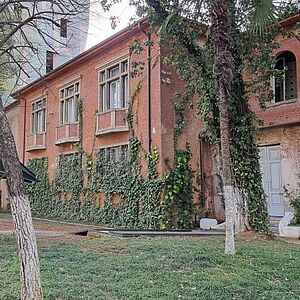
The House of Leaves
From the outside, one might mistake it for a bourgeois villa. However, the red brick walls of this building actually concealed the surveillance headquarters of the Albanian secret police. For decades, the Sigurimi monitored the telephone connections of diplomats, politicians and celebrities from here. The building in downtown Tirana is now a museum. It was curated by the son of a politician – a writer who was unjustly imprisoned in Albania for eight years. The villa-like building was originally [...Read more]
![[Translate to Englisch:] Shkodre Museum](/fileadmin/_processed_/a/6/csm_Shkodre_Museum_Zellengang_fb2b0aba40.jpg)
Shkodër Memorial
The renovated cell doors in the "Site of Witness and Memory" – as the memorial in Shkodër in northwestern Albania calls itself – have a far too shiny glow to them. The memorial is located in a former remand prison of the Albanian Ministry of the Interior. For more than four decades, political prisoners were detained and tortured here. It is the only memorial site in Albania dedicated to the victims of the communist regime. The building, built as a private home in the 19th century, served for many [...Read more]
Argentina
![[Translate to Englisch:] Mechanikerschule der Marine [Translate to Englisch:] ESMA - das Ehemaliges Folterzentrum in Buenos Aires](/fileadmin/_processed_/f/9/csm_ESMA_2_bearb_b794511249.jpg)
ESMA Memorial
At first glance, one would hardly suspect that one of Argentina’s most notorious torture centers used to be located behind these classical pillars. But during the military dictatorship, thousands of people were tortured and killed in the stylish building on the Avenida del Libertador in Buenos Aires. In the meantime, the former Navy Mechanics School (ESMA) has become a memorial site. The Mechanics School was the largest of the many secret prisons in Argentina. Approximately 5,000 people were held [...Read more]
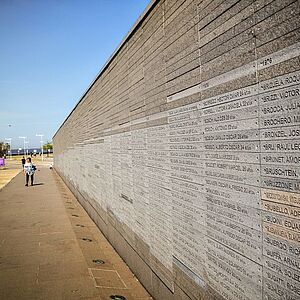
Memory Park
The gray wall juts out like a wedge into the park on the banks of the Río de la Plata. The narrow stone strips contain the many names of people who disappeared during the military dictatorship: names such as “Bruzzone, Marcela, 22 years old” and "Budini, Eduardo Daniel, 19 years old.” The monument to the often very young “victims of state terrorism” is one of the first state memorials established in Argentina. The monument is located inside the Memory Park (Parque de la Memoria) in Buenos Aires, [...Read more]
Cambodia
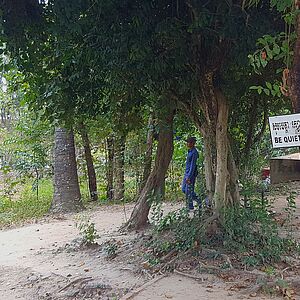
Killing Fields
At first glance, one might mistake the tree-lined grounds for a park – except for the signs everywhere asking visitors to be quiet. It is actually a huge mass grave that the Khmer Rouge created on the outskirts of the Cambodian capital of Phnom Penh. Bone fragments from the 20,000 victims are still visible in the large bomb-like craters of the “Killing Fields.” This was originally the site of a Chinese cemetery. In 1976, the Khmer Rouge began using the abandoned site to kill thousands of people [...Read more]
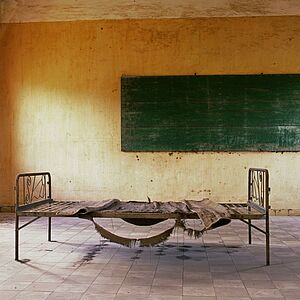
Tuol Sleng Genocide Museum
The blackboard, once used to teach Cambodian students, still hangs on the wall. The Khmer Rouge later turned the school in Phnom Penh into a prison where very few inmates survived. After the Vietnamese invaded, the government established a museum here. Today this disturbing site is visited mostly by tourists. The S-21 prison, the detention center’s official name, was established in a high school in 1976. The classrooms were converted into prison cells and a high-voltage fence was erected around the [...Read more]
Chile
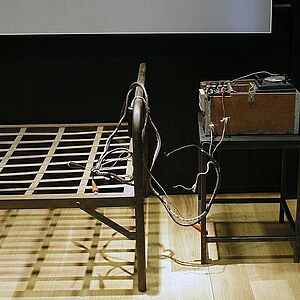
Museum of Memory and Human Rights
An apparatus for administering electric shocks stands next to an iron bed. The Museum of Memory and Human Rights in Santiago de Chile documents the torture of opposition members during the Pinochet dictatorship. Opened in 2010, the museum addresses human rights violations committed in Chile under the military regime from 1973 to 1989. With its modern exhibition and architecture, it has become one of the world’s leading memorial museums. It took more than 20 years for the Chilean state to create a [...Read more]
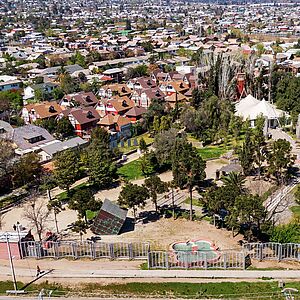
Villa Grimaldi Peace Park
The open space between the detached houses on the outskirts of Santiago de Chile appears out of place. The Villa Grimaldi torture center of the Chilean secret police was established behind a wall here in 1974. The property was forcibly seized from a wealthy Chilean family. With the end of the military dictatorship imminent, the state security service demolished all the buildings. The capital department of the secret police “Dirección de Inteligencia Nacional” (DINA) raided the property shortly [...Read more]
Ethiopia
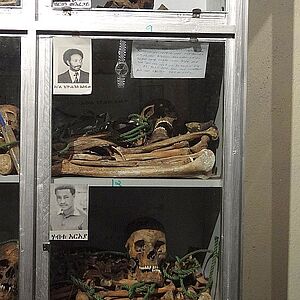
Red Terror Martyrs’ Memorial Museum
A memorial dedicated to the victims of the Marxist Dergue regime was created in the Ethiopian capital of Addis Ababa in 2010. Some of the objects in the museum’s exhibition include blood-smeared clothing, human bones and coffins from the time of the Red Terror. The photo shows a display cabinet containing the human remains of several murder victims. On a tour, visitors learn about how the communist military junta in Ethiopia persecuted dissidents. A sculpture of a mother with two daughters stands at [...Read more]
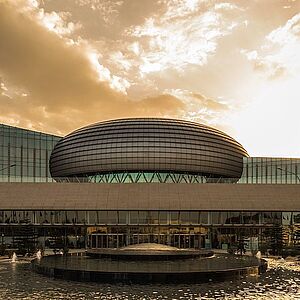
Alem Bekagn Prison
The bombastic headquarters of the African Union in Addis Ababa stands at the former site of Ethiopia’s central prison. The prison building referred to by the locals as “Alem Bekagn” (farewell to the world) was erected in the early 1920s. Sixty members of the royal family and imperial government were murdered here by the Dergue regime in 1974. It is estimated that another 10,000 people were also killed here during the Red Terror. In 1991 the inmates managed to free themselves after the guards had [...Read more]
Georgien
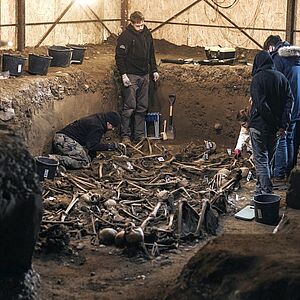
The Mass Grave of Khelvachauri
When the Orthodox Church took over parts of a military site in Batumi in 2017, it made a gruesome discovery: the remains of more than 150 people were found in the ground. A closer inspection of the bones revealed that all of the dead had their hands behind their backs and two holes in their skulls just above the neck. Investigations determined that the victims had been executed by the Soviet secret police. They have yet to receive a dignified commemoration. On April 5, 2019, the Diocese of Batumi [...Read more]
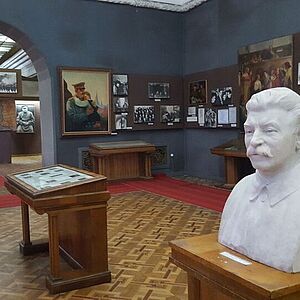
Stalin Museum in Gori
The man with the distinct mustache regards the visitors with a serious but friendly expression. Similar busts of the dictator Josef Stalin used to stand in nearly every public building in the Soviet Union. After his death, as part of the de-Stalinization process, most of these monuments were removed. But in Gori, Georgia, Stalin’s birthplace, an entire museum still honors the man who was responsible for the murder of millions of people. The exhibition, which opened in 1957, has survived practically [...Read more]
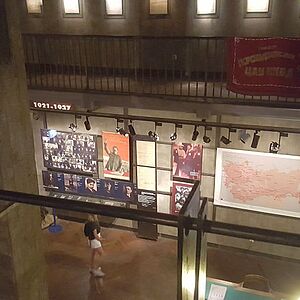
Museum of Soviet Occupation
One looks from the gallery down onto the exhibition hall in Tbilisi. The history of Georgia from 1921 to 1991 is told here over 700 square meters of space. In the Museum of Soviet Occupation, which opened in 2006, visitors learn how the Red Army invaded Georgia over a century ago and how the country became part of the USSR. Seventy years of dictatorship followed. Terrible crimes occurred during this period, the worst of which were the responsibility of none other than two Georgians. The Social [...Read more]
Germany
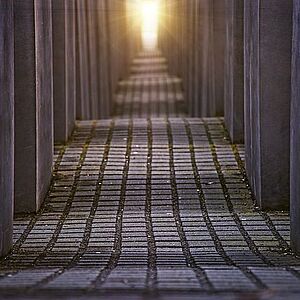
Memorial to the Murdered Jews of Europe
The sunlight flashing through the long passageways of the Berlin Holocaust Memorial could be understood as a symbol of hope. But the Memorial to the Murdered Jews of Europe, as it is officially called, was erected to commemorate a unique crime: the murder of more than six million Jews, mostly through industrial methods, on orders from the Nazi leaders in Germany. The Holocaust Memorial, which officially opened in 2005, is located in Berlin on the former border strip of the GDR, not far from the [...Read more]
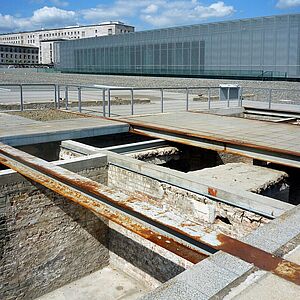
Topography of Terror
A documentation center built on the foundations of the former headquarters of the Secret State Police (Gestapo) provides information about persecution under the Nazis. With almost 1.3 million visitors annually (2019), it is one of the most popular sites of remembrance in Berlin. The 4.5 hectare of exhibition space is located on the grounds that once housed the most important institutions of the Nazi terror apparatus: the Secret State Police in the former School of Arts and Crafts, the Reich SS [...Read more]
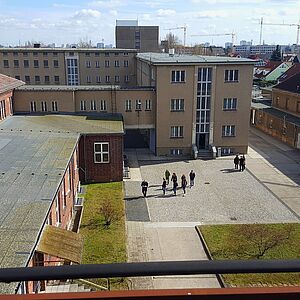
Berlin-Hohenschönhausen Memorial
The central remand prison of the GDR Ministry for State Security is almost completely unchanged. Each year, some 450,000 people visit this oppressive site in the Berlin district of Hohenschönhausen. In 1992, the approximately 170 cells and 120 interrogation rooms were listed as historical monuments. More than 40,000 people were imprisoned in Hohenschönhausen from 1945 to 1990. The Soviet secret police set up Special Camp No. 3 at the site in 1945. In 1947 it became the central remand prison of the [...Read more]
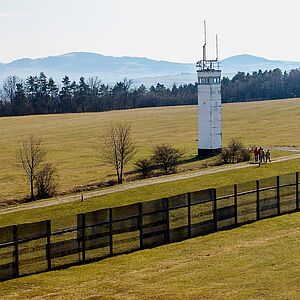
Point Alpha Memorial
Until 1990, the GDR border cut through the middle of Germany over a length of almost 1400 kilometers. Very little of the massive fortifications has been preserved. The largest memorial site commemorating German division is located between the states of Hesse and Thuringia. This is where the U.S Army’s observation post "Point Alpha" was located. If there had been a Third World War between NATO and the Warsaw Pact, it probably would have started here. In an escalation of events, the West expected [...Read more]
Peru
![[Translate to Englisch:] Museum de la Memoria](/fileadmin/_processed_/4/4/csm_bea_Edificio_ANFASEP_b271571137.jpg)
Ayacucho Memorial Museum
No Peruvian city has suffered more from the guerrilla warfare than Ayacucho. The former colonial city on the eastern slope of the Andes was the birthplace and stronghold of the Shining Path organization. The organization wanted to follow Mao Tse-Tung's example and carry the revolution from here into the countryside. Its leader Abimael Guzmán had previously been a professor of philosophy at the local university. The National Association of Relatives of Abducted, Detained and Disappeared Persons of [...Read more]
![[Translate to Englisch:] Lugar de Memoria](/fileadmin/_processed_/3/5/csm_Museo_de_la_Memoria__Peru__bea_9aa74d4d86.jpg)
Lugar de la Memoria
"Lugar de la Memoria" (Place of Memory) looms in large letters at the entrance to the concrete building that rises off the steep coast of the Peruvian capital, Lima. Below this, in smaller letters, are written the words "tolerance" and "social inclusion" – goals to which the museum, which opened in 2015, is also committed. The controversies surrounding the museum and its conception also reflect the political conflicts involved in dealing with the civil war-like conflicts that took place in Peru in [...Read more]
![[Translate to Englisch:] Das weinende Auge 2](/fileadmin/_processed_/9/5/csm_Memorial_El_ojo_que_llora__detalle_2__bea_4e6c5302d5.jpg)
The Eye That Cries
The sculptor Lika Mutal, who wanted to create a memorial dedicated to the victims of the many years of violence in Peru, received 32,000 names from the Truth Commission. She inscribed stones with these names and placed them in eleven concentric circles. In the center, she placed a black rock from which water continuously gushes. Originally, her work, entitled "The Eye That Cries," was supposed to be integrated into a larger memorial grove in Lima's Jesús María district. But this never happened. The [...Read more]
Russia
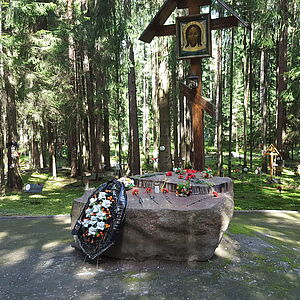
Levashovo Memorial Cemetery
An oppressive silence hovers over the spruce forest of Levashovo. Here on the outskirts of St. Petersburg lie the remains of up to 45,000 executed people. They were shot by the Soviet secret police and buried in nameless mass graves. Members of the human rights organization Memorial discovered the KGB-guarded burial ground in 1989 and achieved having it declared a memorial cemetery. For many relatives, the trees are a substitute for gravestones. The Soviet secret police sealed off the site near [...Read more]
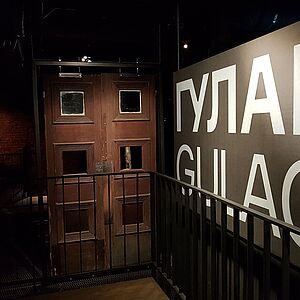
Gulag Museum in Moscow
The huge letters at the entrance to the Moscow Gulag Museum stand for one of the largest camp systems in the world: The Soviet Chief Administration of Corrective Labor Camps and Colonies (GULag) that operated nearly 500 camp complexes with thousands of individual camps. Some 18 million people were imprisoned in them and at least 1.6 million of prisoners died. The museum, funded by the city of Moscow, tells their story in an ambitious permanent exhibition that opened in 2018 and is presented in two [...Read more]
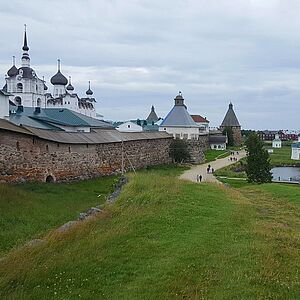
Solovetski Prison Island
The white onion domes rise elegantly behind the thick fieldstone defensive wall. At first glance, one would not suspect that the Soviet Gulags originated here, in a centuries-old monastery on an island in the White Sea. The Bolsheviks established their first labor camp, the Solovetski Special-Purpose Camp (SLON), at the northernmost outpost of the Russian Orthodox Church. Almost everyone in Russia is familiar with the Solovetsky Islands, often affectionately called “Solovki.” The 600-year-old men's [...Read more]
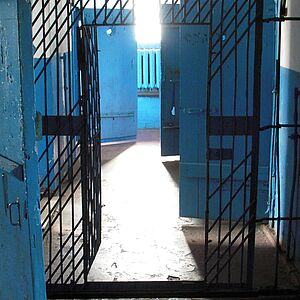
Perm-36 Memorial Museum
Sunlight shines like a glimmer of hope at the end of the cell corridor in the former Perm 36 camp. Members of the human rights organization Memorial discovered the empty prison in 1988 and turned it into a museum. But they were evicted in 2014 under false pretenses. The memorial is now run by the regional government. The history of the memorial, which has received international attention, shows the limits of coming to terms with the past in Russia. The industrial city of Perm, once called the [...Read more]
Rwanda
![Murambi Memorial [Translate to Englisch:] Mumifizierte Tote in der Völkermordgedenkstätte Murambi](/fileadmin/_processed_/d/f/csm_Genocide_Victims_Rwanda_Photo_by_Sascha_Grabow_d9778508eb.jpg)
Murambi Genocide Memorial
Lime has been used to prevent this body from decomposing. About 850 corpses are preserved in this manner to allow them to be displayed in classrooms of a former school near Murambi. Several thousand Tutsis fled into this building in April 1994. After five days, Hutu militias stormed it and killed an estimated 43,000 people with machetes, spears and clubs. The mass graves in which they were later buried were opened a year later. Now parts of the dead were presented alongside the bones, skulls and [...Read more]
![Altar in the Nyamata Memorial [Translate to Englisch:] Altar mit blutbeflecktem Tuch in der Völkermordgedenkstätte Nyamata](/fileadmin/_processed_/2/5/csm_1280px-Nyamata_Genocide_Memorial_Church__463755224__bearb_faa0a6c237.jpg)
Nyamata Genocide Memorial
The scarf on this altar is still covered in blood. Some 10,000 people sought refuge in the former Catholic church in April 1994. But Hutu militias broke holes into the brick walls and through grenades inside. They later stormed the church to shoot or kill the people on the inside with machetes. After the massacre, many more people in the surrounding area were also murdered. Approximately 50,000 dead lie in graves around the building, which is located about 30 kilometers south of Kigali. The church [...Read more]
![Human skulls in the Bisesero memorial [Translate to Englisch:] Menschliche Schädel in der Völkermordgedenkstätte Bisesero](/fileadmin/_processed_/a/3/csm_Bisesero_Genocide_Memorial_Centre_03_Schaedel_Ausschnitt_bearb_3c0a7568e7.jpg)
Bisesero Genocide Memorial
These human skulls serves as a horrific reminder of the events that took place in the Bisesero settlement in the west of Rwanda. Approximately 40,000 people in this area were murdered in 1994. The Tutsi sought help from the French peace troops that were stationed nearby. But the troops withdrew, explaining that they lacked a mandate to intervene. Some of the skulls of the murder victims are displayed in the memorial located about 60 kilometers from Kibuye. On the outdoor grounds, a small monument [...Read more]
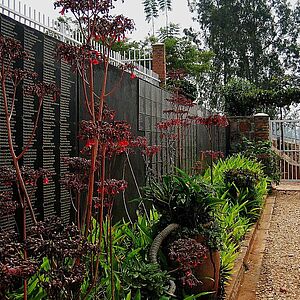
Kigali Genocide Memorial
The “Wall of Names” in the Kigali Genocide Memorial will never be totally complete: of the 250,000 people who were buried here in collective graves, only a small number have yet to be identified. Their corpses were found on the streets of the Rwanda capital of Kigali in 1994. In 2004, with foreign support, a national memorial site was established next to the graves. It includes a modern permanent exhibition, an educational center, a garden of reflection and a monument dedicated to the murdered [...Read more]
![Nyarubuye brick church and memorial [Translate to Englisch:] Backsteinkirche und Völkermordgedenkstätte Nyarubuye](/fileadmin/_processed_/e/2/csm_nyarubuye-genocide-memorial_53cba39ff9.jpg)
Nyarubuye Genocide Memorial
Pristine and clean, this large brick church extends upward towards the blue skies of Rwanda. Approximately 20,000 people sought refugee here in 1994. Many of them were fleeing to Tanzania, which is only a few kilometers away. They were murdered within a few days in mid-April. The mayor of the district, Sylvestre Gacumbitsi, played a major role here. He led the attack personally, distributing weapons and using a megaphone to call on the mob to engage in rape and murder. The International Criminal [...Read more]
![The Ntarama church and memorial [Translate to Englisch:] Innenraum der Kirche und Gedenkstätte Ntarama](/fileadmin/_processed_/9/f/csm_1280px-Ntarama_Church_Genocide_Memorial_-_Flickr_-_Dave_Proffer__4__8e5633c6f1.jpg)
Ntarama Genocide Memorial
The benches are neatly aligned in this church in the Bugesera district, about a one-hour car ride to the south of Kigali. But the shelves on the back wall of this former Catholic church are jarring because they contain a dense collection of human skulls. In 1994, about 5,000 people sought safety in the brick building. On April 15, Hutu paramilitary forces carried out a bloodbath and literally butchered the people seeking refuge. Today, individual pieces of clothing from the victims hang on the [...Read more]
South Africa
![[Translate to Englisch:] Ehemaliges Hochsicherheitsgefängnis Robben Island [Translate to Englisch:] Das Hochsicherheitsgefängnis auf Robben Island](/fileadmin/_processed_/1/8/csm_Robben_Island-113368_bearb_05bd31e48b.jpg)
Prison on Robben Island
Robben Island lies about twelve kilometers off the coast of Cape Town. The island owes its name to the seals that used to have their habitat there. Before a lighthouse was erected, numerous ships were wrecked on the treacherous rocks in the water. The imprisonment of political prisoners on the island goes back to the 17th century. The surrounding rough sea made it impossible to escape. In the mid-19th century, over 300 lepers also lived here, at first voluntarily, later against their will. In 1961, [...Read more]
![[Translate to Englisch:] Ausstellungshalle Apartheid-Museum](/fileadmin/_processed_/3/3/csm_Apartheidmuseumhall_bearb_c2834f505d.jpg)
Apartheid Museum in Johannesburg
“Taxi Rank for Whites” reads the white sign in the Apartheid Museum in Johannesburg. It is one of many relics of apartheid policies on display in the museum. The exhibition documents the decades of racial segregation in South Africa. The privately funded museum not only shows the unequal treatment of blacks and whites, but also promotes the values of the first democratic constitution. This may be the only museum in which people of different skin color have to enter through separate entrances. This [...Read more]
Taiwan
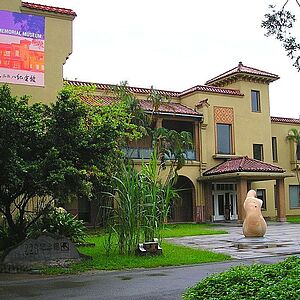
228 - Taipei Memorial
In Taiwan, “228” stands for February 28, 1947. On this day hundreds of Taiwan residents gathered in front of the government seat in Taipei to protest the colonialist conduct of the Chinese central government. The date plays an important role in Taiwan’s remembrance culture. The spontaneous rally was a response to a police shooting of a passerby in a scuffle with a street vendor. When security forces opened fire on demonstrators in front of the government building, some of the protestors forced [...Read more]
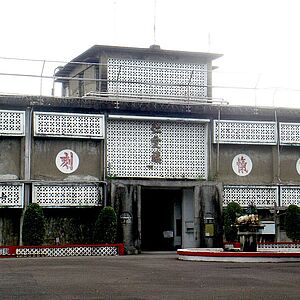
Jing-Mei Memorial Park for the Victims of the White Terror
The military court of the Republic of China used to convene in the Jing-Mei district of the Taiwanese capital Taipei. The court played a key role in prosecuting opposition members in the 1970s and 1980s. During martial law, more than 16,000 people were tried for sedition or espionage. The courtroom and the adjacent prison (photo) are now a memorial. The trial of what is known as the Formosa Incident was held at the military court. Civil rights activists associated with Formosa Magazine had called [...Read more]
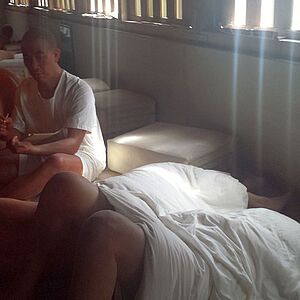
New Life Correctional Center
Reconstructed camp barracks with prisoners The prisoners lie or sit closely packed in barracks of the “New Life” Correctional Center. Its aim was to transform the prisoners into new people through hard labor and mental re-education. Today the camp is a museum, which even includes replicas of the prisoners. The memorial is located on “Green Island,” a small island about 30 kilometers off the east coast of Taiwan. The rocky island in the middle of the Pacific Ocean had previously served as a penal [...Read more]
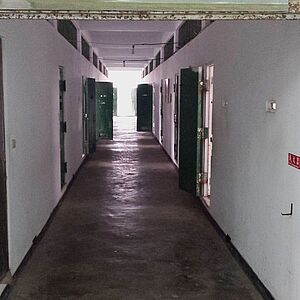
“Villa Oasis” Prison
Seemingly endless rows of green cell doors line the empty jail on the former “Green Island” prison. It was used by the Ministry of National Defense of Taiwan as a so-called reform and re-education prison from 1972 to 1987. The prison with the cynical name “Villa Oasis” is now part of a memorial park. The cell building was erected after a prison revolt on Taiwan’s main island and surrounded by high walls and watchtowers. Political prisoners from various prisons were transferred here so that they [...Read more]
Tunisia
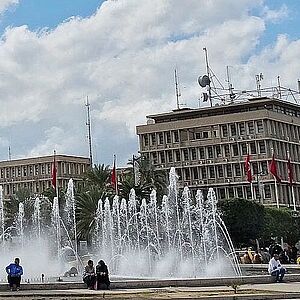
Ministry of the Interior in Tunis
Set behind gushing fountains, the Ministry of the Interior building on Avenue Habib Bourguiba in Tunis looks almost idyllic. But many Tunisians have less-positive memories of this high-security building that served as the residence of the “Directorate of State Security,” Tunisia’s secret police. The clunky building dates back to the French colonial era. There was a small prison on the ground floor. Interrogations and torture took place on the upper levels. For many prisoners, this was where their [...Read more]
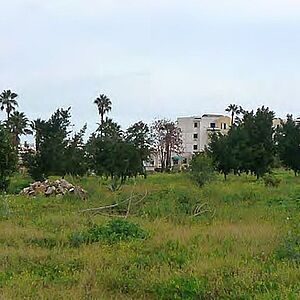
9 April Prison
Nothing suggests that for many decades the largest prison in Tunisia had stood on this overgrown field on Avenue “9 Avril” in Tunis. The prison cell building, designed to hold 1,500 prisoners, was built during the colonial period. But the number of inmates held here during the dictatorship under Bourguiba and Ben Ali was often higher. After Tunisia acquired independence, thousands of political prisoners were held in the building. It also contained a guillotine, which was still in use in the early [...Read more]
Ukraine
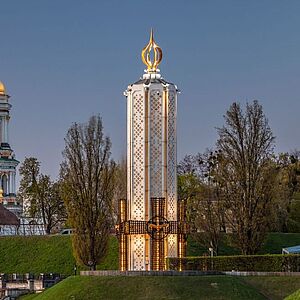
Holodomor Museum in Kiev
The memorial to the victims of the Ukrainian famine in 1932/33 rises above Kiev like a burning candle. The 30-meter-high bell tower, which culminates in a golden flame, was inaugurated in 2008. A museum that opened beneath it the following year explains how orders from the Soviet leadership led to the death of at least 3.5 million people in Ukraine. Remembering the Holodomor, which was not spoken about for decades, also serves to strengthen Ukrainian national consciousness. Before the country [...Read more]
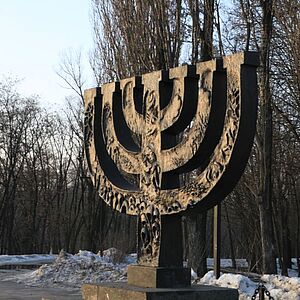
Holocaust Memorial Babi Yar
It took 50 years for the victims of one of the largest mass executions of World War II to be commemorated. In 1991, a seven-armed candelabrum was erected in memory of the more than 30,000 Jews who were shot outside of Kiev. Following the Wehrmacht invasion in 1941, they were killed in the Babi Yar ravine within 36 hours. Another 25 years passed before Ukraine agreed to build a museum here. But now, with the Russian invasion, its future is uncertain. When the Wehrmacht’s 6th Army entered Kiev on [...Read more]
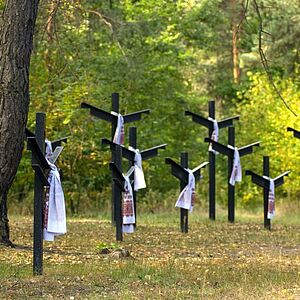
The Graves of Bykivnia
These crosses in a forest near Kiev resemble people taking flight. They commemorate the dead who were buried here during the period of the Soviet Union. Nearly 130,000 people are believed to be buried here, all of them murdered by the Soviet secret police, the NKVD. The mass grave was discovered in 1941, when the Wehrmacht invaded the USSR. But a cloak of silence descended over the site after the war. The dead were not commemorated until after Ukrainian independence. By 1930 at the latest, the [...Read more]